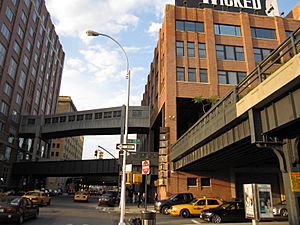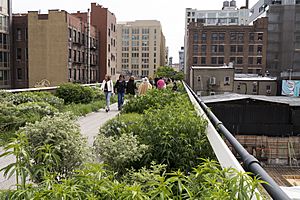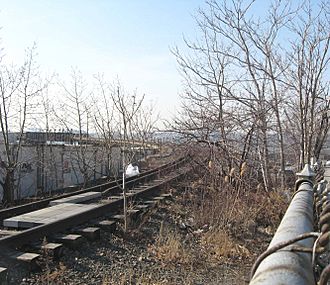High Line facts for kids
Quick facts for kids High Line |
|
|---|---|

The High Line by 18th Street
|
|
|
Interactive route mapInteractive route map [show]
<mapframe frameless width="220" height="590" zoom="15" latitude="40.747633" longitude="-74.004886" align="center">
[ { "type": "ExternalData", "service": "geoshape", "ids": "Q843869", "properties": { "stroke": "#325b32", "stroke-width": 2, } }, { "type": "Feature", "geometry": { "type": "Point", "coordinates": [-74.008202, 40.739502]}, "properties": { "title": "Gansevoort St: elevator and stairs", "marker-size": "small", "marker-symbol": "disability" } }, { "type": "Feature", "geometry": { "type": "Point", "coordinates": [-74.007871, 40.741890]}, "properties": { "title": "14th St: elevator and stairs", "marker-size": "small", "marker-symbol": "disability" } }, { "type": "Feature", "geometry": { "type": "Point", "coordinates": [-74.006973, 40.743417]}, "properties": { "title": "16th St: elevator and stairs", "marker-size": "small", "marker-symbol": "disability" } }, { "type": "Feature", "geometry": { "type": "Point", "coordinates": [-74.006045, 40.745962]}, "properties": { "title": "20th St: stairs", "marker-size": "small", "marker-symbol": "entrance" } }, { "type": "Feature", "geometry": { "type": "Point", "coordinates": [-74.004712, 40.747814]}, "properties": { "title": "23rd St: elevator and stairs", "marker-size": "small", "marker-symbol": "disability" } }, { "type": "Feature", "geometry": { "type": "Point", "coordinates": [-74.003376, 40.749916]}, "properties": { "title": "26th St: stairs", "marker-size": "small", "marker-symbol": "entrance" } }, { "type": "Feature", "geometry": { "type": "Point", "coordinates": [-74.002543, 40.751074]}, "properties": { "title": "28th St: stairs", "marker-size": "small", "marker-symbol": "entrance" } }, { "type": "Feature", "geometry": { "type": "Point", "coordinates": [-74.001949, 40.752334]}, "properties": { "title": "30th St: elevator and stairs", "marker-size": "small", "marker-symbol": "disability" } }, { "type": "Feature", "geometry": { "type": "Point", "coordinates": [-74.003988, 40.753423]}, "properties": { "title": "30th St and 11th Ave: stairs", "marker-size": "small", "marker-symbol": "entrance" } }, { "type": "Feature", "geometry": { "type": "Point", "coordinates": [-74.001077, 40.752158]}, "properties": { "title": "30th St and 10th Ave: stairs", "marker-size": "small", "marker-symbol": "entrance" } }, { "type": "Feature", "geometry": { "type": "Point", "coordinates": [-74.003671, 40.756319]}, "properties": { "title": "34th St: accessible ramp", "marker-size": "small", "marker-symbol": "disability" } } ] </mapframe>Hover over each pin for information |
|
| Type | Elevated urban linear park; public park |
| Location | Manhattan, New York City |
| Area | A linear 1.45-mile (2.33 km) stretch of viaduct |
| Created | 2009 |
| Operated by | New York City Department of Parks and Recreation |
| Visitors | 8 million (2019) |
| Status | Operating |
| Public transit access | New York City Subway: 34th St–Hudson Yards ( 14th Street–Eighth Avenue ( New York City Bus: M11, M12, M14A, M14D, M23 SBS, M34 SBS at various places |
| Website | www.thehighline.org |
The High Line is a unique park in New York City. It's built on an old, elevated railway track. This track used to carry freight trains on the west side of Manhattan.
The park is about 1.45 miles (2.33 km) long. It stretches through different neighborhoods. These include the Meatpacking District and Chelsea. The High Line starts at Gansevoort Street and goes up to 34th Street.
The railway was abandoned in 1980. People then decided to turn it into a beautiful park. The design was a team effort. It involved landscape architects, urban designers, and experts in nature. The park opened in parts, starting in 2009. The final section opened in 2019.
The High Line has become very popular. It attracts millions of visitors each year. It has also inspired other cities. Many now want to turn their old railway lines into parks.
Contents
Exploring the High Line
The High Line is a long, narrow park. It runs for about 1.45 miles (2.33 km). You can find it on the west side of Manhattan. The park is open every day. Its hours change with the seasons. It closes later in summer.
There are many ways to enter the park. Some entrances have stairs and elevators. These are good for people with disabilities. You can find these at Gansevoort, 14th, 16th, 23rd, and 30th Streets. Other entrances have only stairs.
What You'll See
The High Line is full of interesting spots. At the south end, there's the Tiffany and Co. Foundation Overlook. It offers great views. You'll also pass under The Standard, High Line hotel.
Near 14th Street, the park splits into two paths. One has a water feature. The other has a sundeck for relaxing. The High Line even goes through the Chelsea Market building. This is a famous food hall.
At 17th Street, you'll find the Tenth Avenue Square. It's like an outdoor theater. You can sit and watch the city below. There's also a lawn at 23rd Street. It's a perfect spot to rest.
Further north, you'll see the Philip Falcone and Lisa Maria Falcone Flyover. This ramp takes you above the park. It gives you a great view of the city. The park then curves west. It leads to the Tenth Avenue Spur. This part has tall ceilings and a large garden. It also features temporary art shows.
The park has a fun play area. It uses old rail ties. There are also special "Pershing Beams." These are soft, silicone-covered beams. You can even walk between old railroad tracks here. Some benches are like seesaws. Others make sounds when you tap them.
Plants and Art
The High Line's plants are special. They are inspired by the wild plants. These plants used to grow on the abandoned tracks. You'll see many types of grasses and flowers. There are also trees like sumac and birch. The park's design mixes paved paths with natural plants. It looks like the plants are growing right through the walkways.
The park also features amazing art. It hosts temporary art installations and performances. One famous artwork is The River That Flows Both Ways. It's made of 700 glass panes. Each pane's color matches a pixel from a photo of the Hudson River. This creates a long portrait of the river.
You might also see sculptures. Some are made for birds and butterflies. Others look like empty billboards. There are even audio messages in restrooms and elevators. These are part of an art piece called Digital Empathy. Many artists have shown their work here. This includes large sculptures and unique displays.
High Line's Story
From Trains to Park
Long ago, in 1847, trains ran on the streets of Manhattan. These were freight trains. They carried goods like coal and milk. But they caused many accidents. People called the area "Death Avenue."
To make things safer, a big project started in 1929. It was called the West Side Improvement Project. This project moved the train tracks off the streets. They built an elevated structure, high above the ground. This structure is what we now call the High Line.
The first train ran on the elevated High Line in 1933. It was designed to go through city blocks. This meant trains could load and unload goods directly inside factories and warehouses. This helped transport goods without blocking street traffic.
The Tracks Go Quiet
In the 1950s, trucks became more popular. Train traffic slowly decreased. By 1978, only a few train cars used the High Line each week. The last train ran in 1980. It carried frozen turkeys. After that, the tracks were no longer used.
For many years, the High Line sat empty. Wild plants started to grow on the tracks. Some people wanted to tear it down. But others saw its potential. They wanted to save it.
Saving the High Line
In 1999, a group of friends formed an organization. They called themselves "Friends of the High Line." Joshua David and Robert Hammond led this group. They wanted to turn the old railway into a public park. They were inspired by a similar park in Paris.
They worked hard to get support. A photographer named Joel Sternfeld took pictures of the overgrown tracks. These photos showed the wild beauty of the abandoned line. They helped convince people to save it. Many famous people also helped raise money.
In 2003, Friends of the High Line held a design contest. Over 720 people from around the world submitted ideas. The city government also got involved. Mayor Michael Bloomberg supported the project. In 2005, the city officially took ownership of the High Line.
Building the Park
Construction began in 2006. The park was designed by a team of experts. This included James Corner Field Operations and Diller Scofidio + Renfro. Piet Oudolf, a Dutch garden designer, planned the plants.
The park opened in phases:
- The first section opened in June 2009. It went from Gansevoort Street to 20th Street.
- The second section opened in June 2011. It extended the park to 30th Street.
- The final section opened in September 2014. It reached 34th Street.
- The Tenth Avenue Spur, a special part with art, opened in June 2019.
In 2020, the High Line temporarily closed due to the COVID-19 pandemic. It reopened with special rules. Visitors needed timed passes and could only walk in one direction.
There are also plans to extend the High Line even further. One idea is to connect it to Moynihan Train Hall. Another is to extend it north to the Javits Center and Hudson River Park.
Friends of the High Line
The park is managed by the "Friends of the High Line" organization. Joshua David and Robert Hammond founded this group. They played a huge role in saving the old railway. They convinced the city to turn it into a park.
This organization is in charge of the park's daily operations. They keep it clean and beautiful. They also raise most of the money needed to run the park. They get funds from private donations. They have many employees and volunteers who help maintain the High Line.
High Line's Impact
The High Line has become one of New York City's most popular attractions. Millions of people visit it every year. Most visitors are tourists. Some local residents feel it has become too crowded with tourists.
Neighborhood Changes
The park has brought new life to the neighborhoods around it. Areas like Chelsea used to be run-down. Now, they are lively and popular. The High Line has encouraged new buildings and businesses to open nearby. This has also made properties next to the park more valuable.
Many people have moved into apartments near the High Line. They enjoy living close to the park. However, some older businesses in the area have closed. This is because rents have gone up. Some people worry that the park has changed the neighborhood too much. It has become more expensive.
The High Line has also attracted new museums. The Whitney Museum of American Art built a new home right next to the park. It opened in 2015.
Inspiring Other Cities
The success of the High Line has inspired cities all over the world. Many now want to transform their own old railway lines into parks. This is sometimes called the "High Line effect."
Cities like Philadelphia, Atlanta, and Chicago are planning similar projects. It can be cheaper to turn an old rail line into a park than to tear it down. However, the High Line's designer, James Corner, says it's not easy to copy. A successful park needs a good neighborhood around it.
Friends of the High Line has even created a "High Line Network." This group helps other cities develop their own elevated parks. There are many projects in this network. They share ideas and support each other.
See also
 In Spanish: High Line (Nueva York) para niños
In Spanish: High Line (Nueva York) para niños





